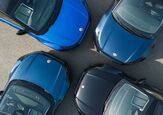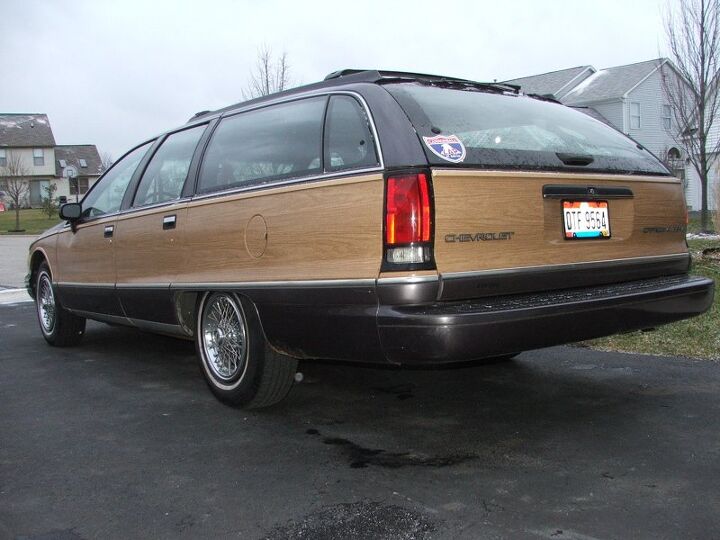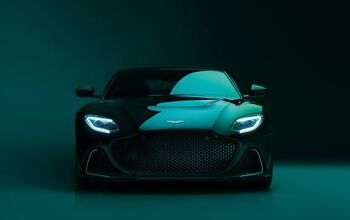Capsule Review: 1991 Caprice Classic Estate

Donk, Box, Bubble. Say it with me now. Donk, Box, Bubble. And thus the full-size General Motors “B-body” exists in the argot of the urban street. The Donk is the long, flowing, Baroque fifth-generation Impala and its platform twins, sold from 1971 to 1976. The Box is the tidy 1977 model, downsized to perfect, squared-off proportions. To this day, I am not certain that there is a cleaner visual expression of the American full-sized car than the 1977 Impala. Last but not least, we have the Bubble, as seen above. The Bubble was sold as the Caprice Classic (and Impala SS) from 1991 to 1996.
This is my Bubble. Or, I should say, was my Bubble, a casualty on one of the many nameless hills and dimly remembered battles which characterized my marriage. Purchased for $1200 with fifty thousand miles on the clock, it was quiet, reliable, and characterful to a fault. I loved that car. But the boss said I could not own three full-sized cars (I also had two Phaetons at the time) so the Bubble had to be popped.
No, my wagon did not have the LT1. Later Caprice wagons had the iconic powerplant, heart of the revitalized fourth-generation Corvette, (under)rated for 260 horsepower and ignited by the unreliable, reviled Opti-Spark. (Simply placing the word “Opti-Spark” into a search engine will be your ticket to an afternoon’s pleasurable perusal of all the many and varied ways by which rural Americans can textually disrespect an ignition system.) My Caprice was the L05 350. This was an absolutely typical Small Block Chevrolet. It didn’t like to rev, but it was very smooth and it could spin the rear tires on command. I put new Goodyears on and spent a happy winter with the nose pointing sideways towards the inside apexes of suburban corners and freeway-offramps.
Red velour. This was my second car to have such an interior; the first was my red 1980 Mercury Marquis Brougham Coupe. I’m a sucker for red velour. These are great seats, comfortable for the long haul in a manner completely different from an Audi or Porsche chair. Oddly enough, the rear seats weren’t terribly spacious. I’d been in the back seat of a police Caprice and attributed the cramping to the divider, but my woody wagon wasn’t much better. Tall people were best placed up front.
Alternately, they could sit all the way in the back. I never ceased to be amused and pleased by the demands I received from thirtysomethings to sit in the “wayback”. There’s something nostalgic about being back there, looking at where you’ve been rather than where you’re going. Make no mistake, however; if you were over five feet tall you’d be hugging your knees. Also, had I ever tossed the big Caprice off the road during my snowy excursions, I’m certain the rear passengers would not have survived. I never let the really fine broads sit back there; attractive women are our last national resource now that all the oil is floating in the sea.
The Caprice Classic Estate and its spiritual rival, the Ford LTD County Squire, were the last American cars to enjoy impeccable upper-class credentials. As a child living on the East Coast, and later growing up in Upper Arlington, Ohio, I noted early that these big wagons were commonly paired with Volvos, Mercedes W123s, or even Porsche 911s in the driveways of the well-to-do. This wagon could still do the business; although it was not luxurious in the manner of a contemporaneous LS400 or 500SEL, it was honest and comfortable. The wood decals on the side are, I feel, mandatory.
My own use of the Estate was far from upper-class. I’d managed to once again find myself in desperate need of employment and had agreed to work the 6:30-to-2:30 shift at a local captive Japanese auto manufacturing facility. I would have been happy to assemble the bland sedans and awkwardly-wedgy entry-level luxury cars built there, but instead I was tasked with disassembling, documenting, and improving the timeclock systems in use. It became apparent to me that the physical protection of the timeclocks located near the shift stations was paramount. The employees knew that destroying a timeclock at their shift station would permit them to walk five minutes to the exit for clock-in and out. Ten minutes of one’s own, stolen from and paid for by the hated mother company! When I arranged to protect them with a Lexan shield, battery acid was poured into them using can-and-tube improvisations.
I spent my half-hour lunch as so: I walked to the exit timeclock (oh yes, my local one was “under review”), ate my lunch in the front seat of the Caprice, and then slept for eighteen minutes in the flattened-out cargo area. Sheer bliss, even though it mussed the Zanella trousers I insisted on wearing underneath my company coveralls. Every morning, I would park the Caprice and walk in, crossing paths with the mussed, sweaty, but improbably lovely nineteen-year-old girls working third shift on their first year with the company. Sometimes they had a smile for me, sometimes not. I imagined that I had grown up there, taken the default job of the community, met a forthright farm-town beauty, and settled down into a life of assembly and televised sports.
One day the ultimatum came. The Caprice must go. It was leaking a small amount of oil. I contacted a man who owned over ninety of the big bubbles and was saving them for the future. He paid me three thousand dollars. It was the only car deal in my life to ever make me a buck. I went into the garage the next morning, fired up my 911, and drove to the factory. I couldn’t sleep at lunch. I was angry. I came home and did not return to that job. Goodbye, bubble.

More by Jack Baruth
Latest Car Reviews
Read moreLatest Product Reviews
Read moreRecent Comments
- Spectator Wild to me the US sent like $100B overseas for other peoples wars while we clammer over .1% of that money being used to promote EVs in our country.
- Spectator got a pic of that 27 inch screen? That sounds massive!
- MaintenanceCosts "And with ANY car, always budget for maintenance."The question is whether you have to budget a thousand bucks (or euro) a year, or a quarter of your income.
- FreedMike The NASCAR race was a dandy. That finish…
- EBFlex It’s ironic that the typical low IQ big government simps are all over this yet we’re completely silent when oil companies took massive losses during Covid. Funny how that’s fine but profits aren’t. These people have no idea how business works.







































Comments
Join the conversation
It would be interesting to how the Olds Vista roof window design came to be.
Great read, glad to see these wagons get some love for a change. After 9 GM B-body sedans myself, I stumbled upon a 1991 Caprice wagon with the porno red interior and 95k miles garaged kept at somebody's grandma's house for $1800. After driving it for the last year now, it's making me want to replace my other Caprice I also have, a sedan, with yet another wagon. Had a 1991 Roadmaster hearse on our local Craigslist last fall with 80k miles for $1500 bucks, I didn't buy it because I was stupid.